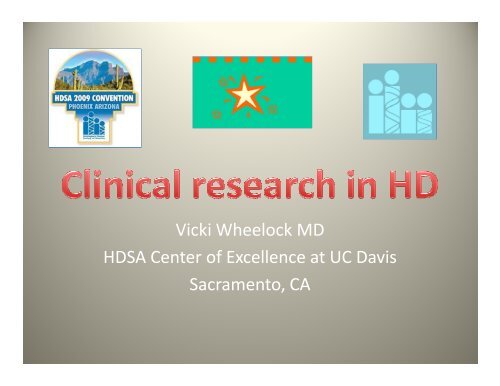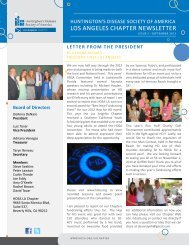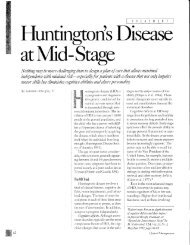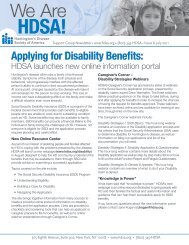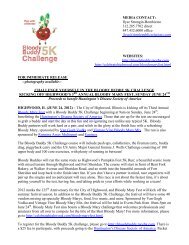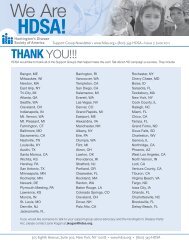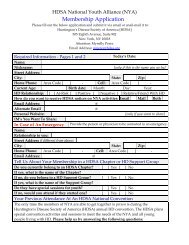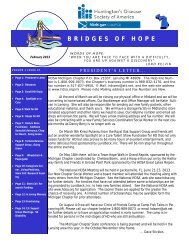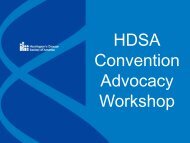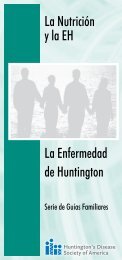Vicki Wheelock MD HDSA Center of Excellence at UC Davis ...
Vicki Wheelock MD HDSA Center of Excellence at UC Davis ...
Vicki Wheelock MD HDSA Center of Excellence at UC Davis ...
Create successful ePaper yourself
Turn your PDF publications into a flip-book with our unique Google optimized e-Paper software.
<strong>Vicki</strong> <strong>Wheelock</strong> <strong>MD</strong><br />
<strong>HDSA</strong> <strong>Center</strong> <strong>of</strong> <strong>Excellence</strong> <strong>at</strong> <strong>UC</strong> <strong>Davis</strong><br />
Sacramento, CA
The inform<strong>at</strong>ion provided by speakers in<br />
workshops, forums, sharing/networking sessions<br />
and any other educ<strong>at</strong>ional present<strong>at</strong>ion made as<br />
part <strong>of</strong> the 2009 <strong>HDSA</strong> convention program is for<br />
inform<strong>at</strong>ional use only.<br />
<strong>HDSA</strong> encourages all <strong>at</strong>tendees to consult<br />
with their primary care provider, neurologist or<br />
other healthcare provider about any advice,<br />
exercise, medic<strong>at</strong>ion, tre<strong>at</strong>ment, nutritional<br />
supplement or regimen th<strong>at</strong> may have been<br />
mentioned as part <strong>of</strong> any present<strong>at</strong>ion.
Presenter Disclosures<br />
Dr. <strong>Vicki</strong> <strong>Wheelock</strong><br />
The following personal financial rel<strong>at</strong>ionships with commercial<br />
interests relevant to this present<strong>at</strong>ion existed during the past 12<br />
months:<br />
No rel<strong>at</strong>ionships to disclose or list<br />
H · S · G<br />
Huntington · Study · Group<br />
Dr. <strong>Wheelock</strong> is the director <strong>of</strong> the<br />
<strong>HDSA</strong> <strong>Center</strong> <strong>of</strong> <strong>Excellence</strong> <strong>at</strong> <strong>UC</strong><br />
<strong>Davis</strong>, a site investig<strong>at</strong>or for the HSG<br />
since 1997, and a member <strong>of</strong> the<br />
HSG Executive Committee.
Questions<br />
• Wh<strong>at</strong> is a clinical trial?<br />
• Wh<strong>at</strong> is an observ<strong>at</strong>ional trial?<br />
• Who can particip<strong>at</strong>e in research studies?<br />
• How much time does it require?<br />
• Wh<strong>at</strong> about confidentiality?<br />
• Why do people volunteer to particip<strong>at</strong>e in<br />
research?<br />
• Why do people decide not to volunteer?<br />
• Wh<strong>at</strong> HD clinical trials are enrolling right now?
Clinical research studies, especially clinical<br />
trials, are how new knowledge is gener<strong>at</strong>ed,<br />
and they help to find new tre<strong>at</strong>ments. Being a<br />
research participant is not for everyone, but<br />
without participants there cannot be new<br />
tre<strong>at</strong>ments in the future.<br />
Source: The Huntington Study Group Web Site
HD Clinical research: definition<br />
• The goal <strong>of</strong> clinical research is to study<br />
inform<strong>at</strong>ion collected about people enrolled in<br />
order to learn about the manifest<strong>at</strong>ions <strong>of</strong> a<br />
disease, or to test the safety, benefit, side effects<br />
and risks <strong>of</strong> an intervention designed to help<br />
people affected by a disease.<br />
• Types <strong>of</strong> clinical research:<br />
– Observ<strong>at</strong>ional study<br />
– Clinical trials<br />
• Double blind, randomized control trials<br />
• Phase I, II, III
The p<strong>at</strong>hway to finding new drugs<br />
Pre-clinical: models<br />
Phase I: test in healthy humans for safety<br />
Phase II: Test in small popul<strong>at</strong>ion with<br />
disease for safety and dosing<br />
Phase III: Test in larger popul<strong>at</strong>ion for<br />
efficacy<br />
FDA Approval<br />
7
Wh<strong>at</strong> are observ<strong>at</strong>ional trials?<br />
• These are studies involving humans th<strong>at</strong> follow<br />
research participants over time without making a<br />
tre<strong>at</strong>ment intervention.<br />
• Observ<strong>at</strong>ional studies allow researchers to study<br />
the progression <strong>of</strong> HD over time in a number <strong>of</strong><br />
individuals, and help us to understand the<br />
symptoms people experience, the signs noticed<br />
by investig<strong>at</strong>ors <strong>at</strong> the sites, the r<strong>at</strong>e <strong>of</strong><br />
progression, and sometimes markers <strong>of</strong> HD such<br />
as brain scan or blood test changes.
Wh<strong>at</strong> are double blind, randomized,<br />
controlled studies?<br />
• These studies are<br />
designed to helps<br />
prevent judgment or bias<br />
by the investig<strong>at</strong>ors or<br />
research subjects from<br />
affecting the study<br />
results.<br />
• Double blind: neither the<br />
investig<strong>at</strong>or nor the<br />
participant can tell if the<br />
participant is taking the<br />
active drug or a placebo.
Wh<strong>at</strong> are double blind, randomized,<br />
controlled studies?<br />
Randomized: the study<br />
participant is assigned<br />
randomly to either active drug<br />
or placebo<br />
Controlled: The study drug is<br />
compared to an known tre<strong>at</strong>ment<br />
(active control) or to a placebo<br />
(inactive compound th<strong>at</strong> appears<br />
identical to the active drug).
Who can particip<strong>at</strong>e in clinical trials?<br />
• The study protocol is a research plan or roadmap<br />
designed to best answer the question posed by the<br />
study.<br />
• The protocol includes criteria for who is eligible. This<br />
could include:<br />
– people with HD <strong>at</strong> early, mid- or l<strong>at</strong>e-stage<br />
– People <strong>at</strong> 50% risk for the HD CAG expansion<br />
– Family members who are not <strong>at</strong> risk for HD, or people who<br />
have undergone predictive testing and don’t have the HD<br />
CAG expansion<br />
– People with the HD gene expansion who don’t yet have<br />
symptoms
Who can particip<strong>at</strong>e in clinical trials?<br />
• Ability to give informed consent<br />
• Age criteria<br />
• Other medical conditions<br />
– Safety labs<br />
• Psychi<strong>at</strong>ric conditions<br />
– Must be stable<br />
• Other medic<strong>at</strong>ions<br />
– Some may not be allowed
How much time is required?<br />
• Studies vary in dur<strong>at</strong>ion, number <strong>of</strong> activities<br />
carried out <strong>at</strong> study visits<br />
– Observ<strong>at</strong>ional studies can last many years<br />
• Visits are usually just once a year<br />
– Clinical trials could last 3 months – 5 years<br />
• Visits are frequent for Phase II trials (every 1-4 weeks)<br />
• Visits every 1 – 6 months in longer Phase III studies<br />
– Initial study visits usually last 2 - 3 hours<br />
– Follow-up visits may take as little as 15 minutes, or as<br />
long as several hours<br />
– Sometimes there may be telephone contacts made<br />
between visits
The study team<br />
• Site investig<strong>at</strong>or<br />
• Site coordin<strong>at</strong>or<br />
• Research assistants: handling blood samples,<br />
d<strong>at</strong>a entry
Wh<strong>at</strong> kinds <strong>of</strong> activities take place<br />
during study visits?<br />
• Initial visit: informed consent<br />
– Principles <strong>of</strong> protection <strong>of</strong> human subjects require<br />
approval <strong>of</strong> Institutional Review Boards.<br />
– Informed consent includes a description <strong>of</strong> the aims <strong>of</strong><br />
the study, the procedures th<strong>at</strong> will take place, the<br />
potential benefits, side effects and risks to<br />
participants.<br />
– Participants are invited ask questions for clarific<strong>at</strong>ion<br />
– Often 18 pages long<br />
– Takes about 45 minutes
Wh<strong>at</strong> kinds <strong>of</strong> activities take place during study visits?<br />
• Measuring “vital signs”: blood pressure, pulse<br />
• Drawing a blood sample(s)<br />
• Meet with site investig<strong>at</strong>or to ask how participant<br />
is doing, any health changes, any side effects,<br />
possibly physical exam
Wh<strong>at</strong> kinds <strong>of</strong> activities take place during study visits?<br />
• Meet with site coordin<strong>at</strong>or to<br />
ask about mood or behavior<br />
changes, test thinking, turn in<br />
empty study medic<strong>at</strong>ion bottles<br />
and count pills<br />
• MRI brain scan<br />
• Neuropsychological tests<br />
(memory, thinking, etc)
Read the color <strong>of</strong> the word out loud
Wh<strong>at</strong> about privacy?<br />
• Confidentiality is a prime concern to the HSG<br />
• Participant names and medical inform<strong>at</strong>ion are<br />
known to study site personnel, but NOT to<br />
anyone else involved in the study<br />
• Participants are assigned an ID code <strong>at</strong> the sites;<br />
all communic<strong>at</strong>ions with the central site use ID<br />
code, not names<br />
• Blood samples are assigned bar codes to further<br />
protect privacy<br />
• To d<strong>at</strong>e, there have been no inadvertent<br />
disclosures <strong>of</strong> identity or gene st<strong>at</strong>us
Wh<strong>at</strong> happens after a clinical trial is over?<br />
• The Huntington Study Group is committed to<br />
communic<strong>at</strong>ing the results <strong>of</strong> completed clinical<br />
trials to participants<br />
• Mechanism:<br />
– 1 st : conference call with participants<br />
– HSG website, press releases<br />
• Timing: as soon as the study d<strong>at</strong>a is “locked”<br />
• Learning whether participant was assigned to<br />
active drug or control group may take weeks –<br />
months longer.<br />
H · S · G<br />
Huntington · Study · Group
Current observ<strong>at</strong>ional studies<br />
Study Number Participants<br />
people <strong>at</strong> 50% risk for HD CAG expansion<br />
PHAROS 1001<br />
who chose NOT to undergo predictive<br />
testing, followed every 9 months for 10 years<br />
people who have undergone testing for the<br />
PREDICT 1000<br />
HD CAG expansion, followed annually since<br />
2001<br />
COHORT 1800<br />
people who either have manifest HD, are <strong>at</strong><br />
50% risk, their family members, spouses<br />
who are not <strong>at</strong> risk , followed annually since<br />
2004
Examples <strong>of</strong> recently completed clinical trials<br />
Study No. Medic<strong>at</strong>ion Results<br />
TETRA-HD 84 Tetrabenazine Positive – FDA<br />
approved 2008<br />
TREND-HD 316 Ethyl-EPA (fish oil) Not effective<br />
DIMOND-B 90 Dimebon Looks promising;<br />
Phase 3 trial planned<br />
DOMINO 100 Minocycline Not effective
The HD Pipeline<br />
Source: Marsha Miller, <strong>HDSA</strong> website<br />
FDA approved<br />
Phase 3<br />
Phase 2<br />
Phase 1<br />
Pre-clinical
2008: First drug approved by FDA for HD<br />
Tetrabenazine (TETRA study)<br />
• Double-blind, placebocontrolled<br />
study <strong>of</strong><br />
tetrabenazine in<br />
manifest HD<br />
• 84 people with HD,<br />
randomized 2:1 to TBZ<br />
or placebo for 12<br />
weeks<br />
• Primary endpoint:<br />
chorea score<br />
24
Results: Tetrabenazine<br />
H · S · G<br />
Huntington · Study · Group 25
Tetrabenazine: Xenazine
Getting involved in research:<br />
Five good reasons for particip<strong>at</strong>ing<br />
*from Terry Tempkin*<br />
• You’ve always wanted to help<br />
• You want to contribute to the efforts for a cure<br />
• You have the time<br />
• You care about HD research and future gener<strong>at</strong>ions<br />
• Particip<strong>at</strong>ing in research makes you feel good about<br />
helping to advance tre<strong>at</strong>ment and find a cure
Reasons for NOT particip<strong>at</strong>ing in<br />
clinical research<br />
• I don’t have enough time<br />
– Work, school, family activities<br />
– Caregiving for family members<br />
• I’m concerned about my privacy.<br />
• It’s too stressful to think about HD.<br />
• I don’t want to have physical exams, or thinking<br />
tests; I’m already worried enough.<br />
• I h<strong>at</strong>e having blood tests!<br />
• It’s too far to drive to the nearest study site.<br />
• I don’t want to be on a placebo.
There are reasons for and against<br />
volunteering for clinical research……….
STUDY<br />
Length<br />
<strong>of</strong> study<br />
Active HD studies<br />
Number<br />
<strong>of</strong> visits<br />
Age<br />
HD st<strong>at</strong>us<br />
Participants<br />
COHORT Ongoing 1 15+ All members <strong>of</strong> a family with HD;<br />
can also particip<strong>at</strong>e in other studies<br />
PREDICT Ongoing 1 18+ People who have tested and know<br />
their CAG repe<strong>at</strong> length<br />
HART 4 months 7 18+ People with early-mod HD<br />
2CARE 5 years 14 16+ People with early HD<br />
CREST-E* 3 years 16 18+ People with early HD<br />
PREQUEL* 5 months 7 18+ People with the HD CAG expansion<br />
who don’t have symptoms
COHORT<br />
COHORT<br />
• Cooper<strong>at</strong>ive Huntington’s Research Trial<br />
• Long-term observ<strong>at</strong>ional trial with annual<br />
visits<br />
• Goal: to learn more about the clinical fe<strong>at</strong>ures<br />
<strong>of</strong> HD in order to plan future research studies<br />
aimed <strong>at</strong> delaying onset or slowing<br />
progression <strong>of</strong> HD<br />
• Annual visit<br />
• Currently 40 sites in US and Canada; ~1800<br />
participants enrolled.
COHORT<br />
COHORT<br />
• Includes: clinical exam, collecting blood for<br />
genetic testing, collecting family history, and<br />
collecting and storing blood and urine for<br />
future research.<br />
• Who’s eligible? People with the HD CAG<br />
expansion with or without symptoms, their<br />
parents, spouse, siblings, children or<br />
grandchildren > 18 years.<br />
• New: extension to adolescents age 15-17<br />
32
• Sponsor: NIH<br />
PREDICT study<br />
• Trial type: Observ<strong>at</strong>ional<br />
• Goals:<br />
– To determine wh<strong>at</strong> the earliest signs <strong>of</strong> HD are and when<br />
they begin<br />
– To determine wh<strong>at</strong> the most accur<strong>at</strong>e tests are th<strong>at</strong><br />
clinicians can use in detecting the onset <strong>of</strong> HD<br />
– To determine wh<strong>at</strong> factors influence the age <strong>at</strong> which a<br />
person carrying the HD gene develops the illness<br />
• Who’s eligible?<br />
– People who know their gene st<strong>at</strong>us and have no symptoms<br />
<strong>of</strong> HD
PREDICT–HD Study Activities<br />
Questionnaires<br />
Neuro exam<br />
Blood test<br />
Brain MRI<br />
Neuropsychological<br />
tests
2CARE Study<br />
• Sponsor: NIH, Phase III<br />
• Drug: Coenzyme Q10 2400 mg/day for 5 years<br />
• Trial type: Double-blind, randomized, placebo<br />
controlled<br />
• Previous trials:<br />
– CARE-HD (CoQ10 600 mg/d) suggested slowing <strong>of</strong><br />
disease progression<br />
– Pre-2CARE assessed safety and tolerability <strong>of</strong> different<br />
doses<br />
• Primary endpoint: slowing in r<strong>at</strong>e <strong>of</strong> worsening<br />
H · S · G<br />
Huntington · Study · Group
2CARE study upd<strong>at</strong>e<br />
• 39/43 sites approved<br />
• Enrollment: near 300<br />
(plan for 608), which<br />
is slower than<br />
predicted<br />
• D<strong>at</strong>a Safety<br />
Monitoring Board<br />
meets regularly
HART trial<br />
• Sponsor: Neurosearch, Sweden<br />
• Compound: ACR16<br />
• Mechanism: Dopamine stabilizer<br />
• Trial type: IIb<br />
• Previous trials: Phase II in 28 p<strong>at</strong>ients with HD<br />
for one month showed improvement in<br />
voluntary movement and gait<br />
H · S · G<br />
Huntington · Study · Group
HART trial<br />
• Design: 3 different doses vs placebo in 220<br />
participants<br />
• Dur<strong>at</strong>ion: 3 months<br />
• Outcome measure: primary is motor function,<br />
secondary measures are cognition and<br />
psychi<strong>at</strong>ric function<br />
H · S · G<br />
Huntington · Study · Group
CREST-E study<br />
• Sponsor: NIH, Phase III<br />
• Drug: Cre<strong>at</strong>ine 5 to 40 gm/day*<br />
• Trial type: Double-blind, randomized, placebo<br />
controlled<br />
• Previous trials: Cre<strong>at</strong>ine in HD<br />
• Primary endpoint: slowing in r<strong>at</strong>e <strong>of</strong><br />
progression <strong>of</strong> HD<br />
H · S · G<br />
Huntington · Study · Group<br />
*Must have medical<br />
supervision <strong>at</strong> high doses<br />
to avoid toxicity.
PREQUEL: coming soon<br />
• Sponsor: NIH<br />
• Drug: Coenzyme Q10<br />
• Participants: 110 people with the HD CAG<br />
expansion with no motor findings <strong>of</strong> HD<br />
• Design: all groups on active tre<strong>at</strong>ment<br />
– 600, 1200, 2400 mg CoQ10<br />
• Planned launch: summer 2009<br />
H · S · G<br />
Huntington · Study · Group
H · S · G<br />
Huntington · Study · Group<br />
The Cure<br />
<strong>HDSA</strong><br />
1993: the gene<br />
Mt. Everest<br />
42


